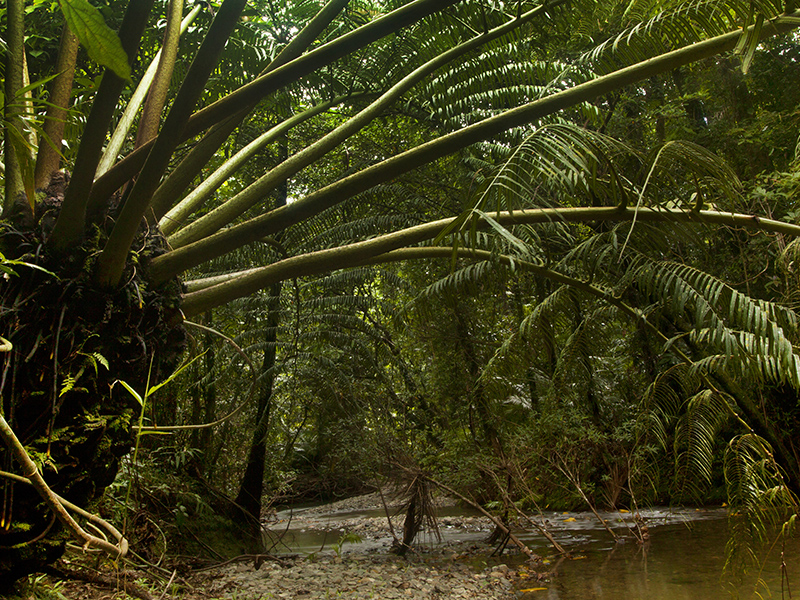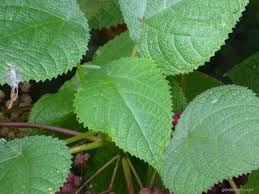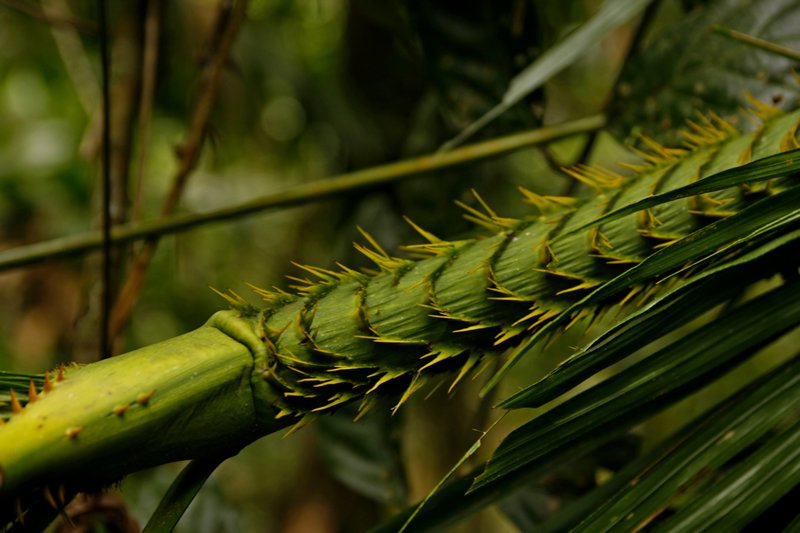Fauna and Flora of Cape Tribulation and the Daintree Rainforest
Flora (continued)
Ferns
King fern
 Ferns are among the most common and most beautiful plants in the Daintree rainforest. Although some of them live on the forest floor, many are epiphytes, plants which live on tree trunks where they have more access to light, water, and nutrients than they would on the ground. Epiphytes are not parasitic and depend on their trees for physical support alone. Ferns in the Daintree area include the basket fern (Dynaria rigidula), bird's nest fern (Asplenium australasicum - epiphyte), and the king fern (Angiopteris evecta), a fern which is reputed to be the world's largest.
Ferns are among the most common and most beautiful plants in the Daintree rainforest. Although some of them live on the forest floor, many are epiphytes, plants which live on tree trunks where they have more access to light, water, and nutrients than they would on the ground. Epiphytes are not parasitic and depend on their trees for physical support alone. Ferns in the Daintree area include the basket fern (Dynaria rigidula), bird's nest fern (Asplenium australasicum - epiphyte), and the king fern (Angiopteris evecta), a fern which is reputed to be the world's largest.
Dangerous plants
No visit to a tropical rainforest website would be complete without a description of the rainforest's dangers, so here's what you've been waiting for - the scary stuff. None of these plants will kill you (well, not usually) but they're all capable of inflicting a lot of pain and/or misery and you should avoid them if possible.
Stinging Tree
Gympie stinger
 There is one variety of stinging tree in the Daintree/Cape Tribulation area: Dendrocnide (translates as "stinging tree")moroides, also called "Gympie Gympie". They sting by injecting a neurotoxin via needle-like fine silica hairs found on the plants' leaves, stems, and small branches. The stinging hairs are very brittle and break off in the skin, injecting the toxin, which, interestingly, affects only the sensory nerves at the site of the injection but does not damage the skin or other tissue. The pain from the sting is both intense and long-lasting, persisting for days and can recur years later if the stung area is re-stimulated, even by something as innocuous as cold water. For more information about the stinging tree its effects, and treatment of stings, see New remedy for stinging tree stings?
There is one variety of stinging tree in the Daintree/Cape Tribulation area: Dendrocnide (translates as "stinging tree")moroides, also called "Gympie Gympie". They sting by injecting a neurotoxin via needle-like fine silica hairs found on the plants' leaves, stems, and small branches. The stinging hairs are very brittle and break off in the skin, injecting the toxin, which, interestingly, affects only the sensory nerves at the site of the injection but does not damage the skin or other tissue. The pain from the sting is both intense and long-lasting, persisting for days and can recur years later if the stung area is re-stimulated, even by something as innocuous as cold water. For more information about the stinging tree its effects, and treatment of stings, see New remedy for stinging tree stings?
Wait-a-while
 The vine-like wait-a-while plant (Calamus) is actually a climbing palm with sharp spikes all over its main stem and hooked, barbed whips (flagella) branching off the main stem. There are 4 species in the area, C. moti (pictured) C. radicalis, C. australis and C. caryotoides. The plant is not toxic, but its hooks can become embedded in the skin and cause it to tear if you try to pull them out (remove by pulling the tip of the tendril away from you). Calamus can produce impenetrable tangles — you have to find a way around them.
The vine-like wait-a-while plant (Calamus) is actually a climbing palm with sharp spikes all over its main stem and hooked, barbed whips (flagella) branching off the main stem. There are 4 species in the area, C. moti (pictured) C. radicalis, C. australis and C. caryotoides. The plant is not toxic, but its hooks can become embedded in the skin and cause it to tear if you try to pull them out (remove by pulling the tip of the tendril away from you). Calamus can produce impenetrable tangles — you have to find a way around them.
Tar tree
 The tar tree (Semecarpus australiensis), a native Australian cashew, has sap which can cause severe allergic skin reactions if touched. Symptoms include blistering, sores, and swelling, which can be incapacitating. It can cause blindness if it comes in contact with the eyes. If you are sensitive to poison ivy - watch out for this (it is not all that common).
The tar tree (Semecarpus australiensis), a native Australian cashew, has sap which can cause severe allergic skin reactions if touched. Symptoms include blistering, sores, and swelling, which can be incapacitating. It can cause blindness if it comes in contact with the eyes. If you are sensitive to poison ivy - watch out for this (it is not all that common).

